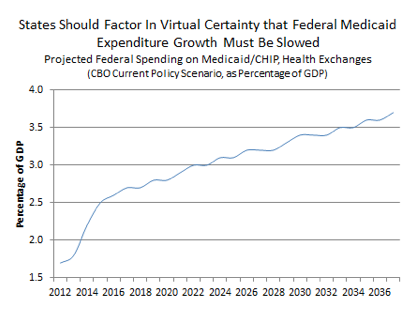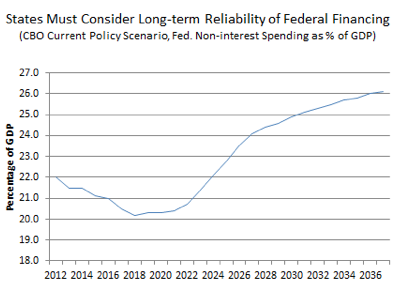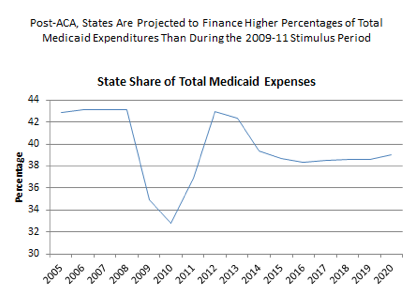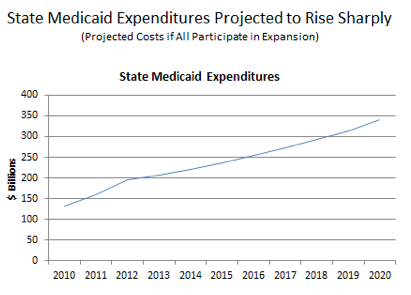- | Government Spending Government Spending
- | Expert Commentary Expert Commentary
- |
Expanding Medicaid: The Conflicting Incentives Facing States
Recent decisions by individual states concerning the Affordable Care Act (ACA)’s now-optional Medicaid expansion have been much in the news of late. Today the Mercatus Center is publishing my comprehensive study of the conflicting incentives facing states as they make their choices about expansion.
Recent decisions by individual states concerning the Affordable Care Act (ACA)’s now-optional Medicaid expansion have been much in the news of late. Today the Mercatus Center is publishing my comprehensive study of the conflicting incentives facing states as they make their choices about expansion.
The decision facing individual states is complex. Setting aside the larger question of whether the ACA’s ambitious coverage expansion is good national policy, several competing factors now bear upon the states’ incentives. These include individual state budget circumstances, the 2012 Supreme Court decision, federal Medicaid financing support levels, the federal government’s own fiscal problems, and interactions between Medicaid and the ACA’s new health exchanges, among many others. Some press coverage has portrayed the current dynamic as a divide between pragmatic governors (choosing to expand) and ideologues (choosing not to). I strongly disagree with that characterization. There are powerful incentives operating against expansion as there are incentives in favor of it; the diversity of state decisions is to be expected even assuming that all governors behave wholly pragmatically.
Some brief background is in order. Through the ACA, federal lawmakers sought to aggressively expand health insurance coverage, choosing the pre-existing Medicaid program as the primary vehicle for covering the previously uninsured poor. The new law expanded the ranks of those that state Medicaid programs must cover to include childless adults with incomes up to 133% of the Federal Poverty Level (FPL) – effectively 138% because of a 5% income exclusion. For 2014–16 the federal government is to finance 100% of the cost of covering the newly eligible population, gradually declining to 90% in the years 2020 and beyond. Last year the Supreme Court ruled that the federal government could not compel the states to expand Medicaid by threatening the withdrawal of their current funding. This decision effectively rendered expansion optional for the states.
Finding #1: For states generally, expansion is a very close call. States now face a value judgment that is anything but trivial. They must weigh the gains of expanded health benefits for their citizens financed primarily by taxpayers residing elsewhere, against the additional costs expansion would pose for their own state budgets that are already strained in many instances. The particulars render this decision a very close call for most states; we should therefore expect different states to make different decisions reflecting their unique budgetary circumstances, subjective value judgments, and the specific needs of their populations.
Beyond theoretical considerations, we know from their historical behavior that states weight these competing considerations differently. Historically Medicaid eligibility has varied significantly from state to state; states have long made very different choices about whether to pursue waivers to expand Medicaid coverage even with the federal government providing the majority of funding for states that have done so.
Finding #2: States face substantial Medicaid cost increases even before budgeting for the optional coverage expansion. Expanding Medicaid exposes states to additional costs at a time when they are already struggling to budget for projected Medicaid cost increases under pre-ACA law. Though under some estimates average state Medicaid costs would further increase by only 3–4% if they expand, this would be layered on top of a huge previously-projected increase. The latest CMS Medicaid report projects state Medicaid costs to grow by 158% cumulatively over the next decade, assuming all states opt for expansion.

Even relative to Medicaid’s troubled history of rapid cost growth, these projections point to a coming cost explosion. They embody substantially higher future growth rates than states faced during the last decade. Yet Medicaid already absorbs 24% of state budgets and is described by the bipartisan State Budget Crisis Task Force as “crowding out other needs.”
One of the factors driving this rising pressure on state budgets is that states’ Medicaid costs were kept artificially low in 2009–11 through federal assistance under the 2009 stimulus law. Thus even with the generous federal assistance rates under the ACA, expanding states would face not only higher costs but a higher percentage of total Medicaid costs going forward than they faced during the 2009–11 period.

Finding #3: After the Supreme Court decision, states face a common incentive to decline to cover childless adults with incomes above the FPL under Medicaid. The ACA establishes federal subsidies for individuals with incomes between 100% and 400% of the FPL if they buy health insurance through newly-established exchanges. Individuals are only eligible for these subsidies if they are not eligible for Medicaid. Insuring these individuals under Medicaid would require states to bear some of the cost of coverage after 2016. By contrast, the federal government would provide the entirety of the subsidy through tax credits if these individuals’ insurance is provided through the exchanges. The states can therefore save money by leaving these individuals uninsured by Medicaid to be insured through the exchanges instead.
Not only would leaving these individuals out of the Medicaid coverage expansion save the states money, it could potentially provide beneficiaries with access to better health services and more generous subsidies. Estimates of the average annual total insurance value under the exchanges are about $9500 by 2022, as opposed to a total value for Medicaid coverage of less than $7000. Leaving these individuals uncovered by Medicaid thus sets up a potential win-win for state taxpayers and ACA beneficiaries alike.
Finding #4: States’ toughest decisions pertain to covering childless adults with incomes below the FPL. Some have suggested that states might come out ahead financially if they cover this population under Medicaid with the ACA’s generous federal match rates. The data suggest otherwise. Expanding Medicaid would increase this population’s health benefits but it would cost states substantial money relative to their current expenditures for financing health care for the uninsured.
Taking into account the historical allocation of the costs of the uninsured’s health services, as well as differences in health service consumption between Medicaid recipients and the uninsured , federal matching rates for the expansion population would probably need to be about 92% over the long term for states to come out ahead. Effective matching rates under the ACA are substantially less: probably about 79% on average given the expected blend of those newly eligible and those already-eligible but previously uncovered (who would bring the lower pre-ACA matching rates) within the expansion population. Because this effective matching rate for expansion is well below states’ break-even point, expansion is expected to cost the states money.
Further adding to the disincentives here is that HHS announced last December that states conducting only partial expansions will not receive the ACA’s enhanced federal match rate. This further reduces incentives for states to expand Medicaid at all.
Finding #5: Future federal cost-shifting to states is virtually certain though the amount is unknown. Given the current state of federal finances, it is unrealistic to assume that the federal government will make all future Medicaid payments now scheduled under law. To return federal spending to historically sustainable norms would require across-the-board spending cuts of roughly 15 percent relative to current levels, and 25 percent relative to projected future levels, to avoid all cuts in the growth of Medicaid and the ACA’s new health exchanges.


Every serious bipartisan budget discussion in recent years has envisioned reductions in future federal Medicaid outlays. The bare minimum of required savings appears to be $100 billion over the next ten years, with much evidence suggesting that the savings required will be closer to $200 billion. I do not agree with those who assert that every dollar cut from federal Medicaid expenditures is a dollar of costs necessarily shifted to states. Nevertheless, if states absorb even half of the effects of federal belt-tightening, they will face further additional costs of the same order of magnitude as the Medicaid expansion.
Finding #6: Given the difficulty of the decision, state negotiations with the federal government could tip the balance. It is clearly against many states’ fiscal interests to expand Medicaid unless they are given the latitude to implement fundamental structural reforms to slow the growth of its costs. That said, states need as much relief from the rising cost baseline as they do from the cost of a possible Medicaid expansion. This gives the states ample incentive to use the prospect of expansion as a bargaining chip to get as much relief as they can from currently-projected financing requirements. Whether states are allowed to implement market-based reforms to improve Medicaid efficiencies could be a critical determinant of whether they are able to handle projected caseload increases with or without the expansion. Given this context, it’s unsurprising to see a series of divergent, individually negotiated state-federal arrangements.
The bottom line is that Medicaid expansion brings additional federally-financed health benefits to the states while exposing state budgets to higher costs. It is reasonable for state governors to reach different conclusions as to which is the overriding factor. Perhaps the only common incentive clearly facing all states is to shift their childless adults above the FPL from Medicaid to the ACA’s new health exchanges and to let the federal government absorb the full cost of their subsidies. Beyond that, much decision-making will depend on whether the states believe they can negotiate satisfactory terms to justify shouldering the costs of expansion, and on how states believe the troubled federal fiscal picture will ultimately be resolved.